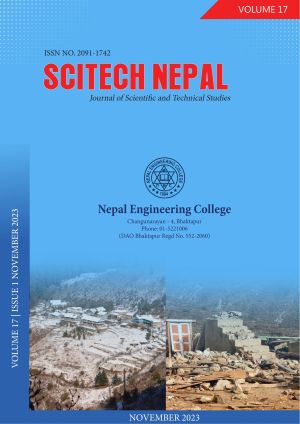Assessment of Rainfall-Induced Shallow Landslides in Kavre District, Nepal
DOI:
https://doi.org/10.3126/scitech.v17i1.60493Keywords:
Antecedent rainfall, Rainfall duration, Rainfall intensity, Rainfall thresholds, Shallow landslidesAbstract
Steep slopes and fragile geology make Nepal a landslide-prone country. Kavre district experiences a large number of shallow landslides in the monsoon season. This research aims to establish rainfall intensity relation with rainfall duration along with rainfall threshold for the initiation of shallow landslides in the Kavre district, Nepal. The six rain gauge stations' rainfall data in the Kavre district from 1987-2016 and landslide data from 1987-2013 were used for establishing rainfall thresholds. The rainfall that risks the landslide event was sorted and the regression analysis of the rainfall and landslide yielded a relationship I =86.738 *D-1.066 having a coefficient of determination R2 = 0.1257. The analysis also incorporates the drawing of the lower boundary which is the 48-h rainfall depth that indicates the rainfall threshold for the initiation of landslide in the Kavre district. The 48-hour rainfall intensity and rainfall depth at which the risk of landslide initiation is high in the Kavre district is 1.4 mm/h. and 67.18mm. Analysis of the antecedent rainfall and the landslide occurrence event indicated that the daily rainfall at failure conditions is better correlated with 3 days of cumulative rainfall at failure than with 5, 7, 10, 15, and 30 days. The study is significant for rainfall-induced landslide disaster management.




